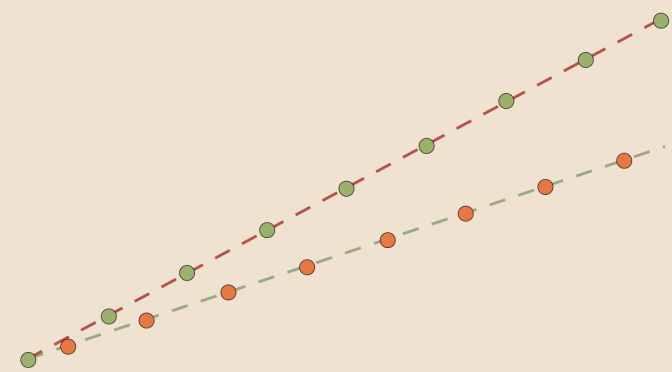In that article, I provide basic counterexamples on sequences convergence. I follow on here with some additional and more advanced examples.
If \((u_n)\) converges then \((\vert u_n \vert )\) converge?
This is true and the proof is based on the reverse triangle inequality: \(\bigl| \vert x \vert – \vert y \vert \bigr| \le \vert x – y \vert\). However the converse doesn’t hold. For example, the sequence \(u_n=(-1)^n\) is such that \(\lim \vert u_n \vert = 1\) while \((u_n)\) diverges.
If for all \(p \in \mathbb{N}\) \(\lim\limits_{n \to +\infty} (u_{n+p} – u_n)=0\) then \((u_n)\) converges?
The assertion is wrong. A simple counterexample is \(u_n= \ln(n+1)\). It is well known that \((u_n)\) diverges. However for any \(p \in \mathbb{N}\) we have \(\lim\limits_{n \to +\infty} (u_{n+p} – u_n) =\ln(1+\frac{p}{n+1})=0\).
The converse proposition is true. Assume that \((u_n)\) is a converging sequence with limit \(l\) and \(p \ge 0\) is any integer. We have \(\vert u_{n+p}-u_n \vert = \vert (u_{n+p}-l)-(u_n-l) \vert \le \vert u_{n+p}-l \vert – \vert u_n-l \vert\) and both terms of the right hand side of the inequality are converging to zero.
If \(\lim (u_{2n} – u_n) = 0\) and \((u_n)\) is increasing then \((u_n)\) converges?
Is not true. However, in order to find a counterexample, we have to pick-up a slowly increasing sequence. As a matter of fact the sequence \(\ln(n+1)\) is increasing too quick as \(\lim \bigl(\ln(2n+1) – \ln(n+1)\bigr) = \ln 2\). The sequence \(u_n=\ln(\ln(n+1))\) provides a counterexample. \(u_n\) is increasing as the function composition of two increasing maps. We also have the equality:
\[u_{2n} – u_n=\ln \left(\frac{\ln 2}{\ln(n+1)}+\frac{\ln(n+1/2)}{\ln(n+1)}\right)\] and the right end side converges to \(0\).
If \((u_n)\) is positive and unbounded then \(u_n \to +\infty\)?
Does not hold. Have a look at \(u_n=\begin{cases} 0 & \text{for } n \text{ even} \\
n & \text{for } n \text{ odd} \end{cases}\)
If \(\lim u_n = +\infty\) then \((u_n)\) is eventually increasing?
Still not! The sequence \(u_n=\begin{cases} n & \text{for } n \text{ even} \\
2n & \text{for } n \text{ odd} \end{cases}\) provides a counterexample.
If \(\lim (u_{n+1} – u_n) = 0\) then \(\lim \frac{u_{n+1}}{u_n} = 1\)?
Is also wrong as you can see with the sequence \(u_n=\begin{cases} \frac{1}{n+1} & \text{for } n \text{ even} \\
\frac{1}{(n+1)^2} & \text{for } n \text{ odd.} \end{cases}\)
If \(\lim (u_{n+1}-u_n) =0 \) and \((u_n)\) is bounded then \((u_n)\) converges?
This is still wrong! But it is slightly more difficult to find a counterexample. One idea is to find a sequence which oscillates between \(0\) and \(1\) with steps decreasing to zero. The sequence:
\[u_n=\begin{cases} 0 & \text{for } n = 0\\
1-\frac{n-2^{2k}}{2^{2k}} & \text{for } 2^{2k} \le n < 2^{2k+1}\\
\frac{n-2^{2k+1}}{2^{2k+1}} & \text{for } 2^{2k+1} \le n < 2^{2k+2}\end{cases}\]
is well defined and having all the required properties:
- for all \(n \in \mathbb{N}\), \(u_n \in [0,1]\), therefore \((u_n)\) is bounded.
- For \(n \ge 2^k\) we have \(\vert u_{n+1}-u_n \vert \le \frac{1}{2^k}\), hence \(\lim (u_{n+1}-u_n) =0 \).
- However, \((u_n)\) diverges as for all \(k \in \mathbb{N}\) we have \(u_{2^{2k}}=1\) and \(u_{2^{2k+1}}=0\).
It is interesting to notice that the set of limit points of \((u_n)\) is the interval \([0,1]\).
The examples above were inspired from mathematical exercises given by math teacher Robert FERRÉOL.


Pretty sure that your counterexample for “If for all p∈N limn→+∞(un+p–un)=0 then (un) converges?” is incorrect.
By hypothesis, p is allowed to range over the entirety of N. The Archimedean property of the naturals and reals ensures there exists a p st. p > n+1 for all n (even if n→∞), and so p/(n+1) = q > 1. So, since ln is increasing, ln(1+q) > ln(1+1) = ln(2) > 0. By this method, both q and ln(1+q) can be made arbitrarily large.
Moreover, I belive that the given condition is actually equivalent to the Cauchy Criterion, and so does imply (and is implied by) the convergence of the sequence.
Also, excellent site! Don’t let the analysis-happy undergrad slow you down.